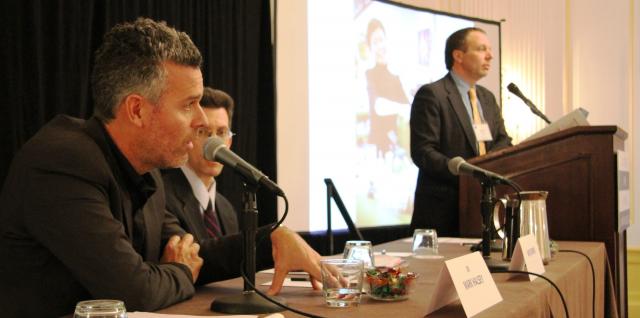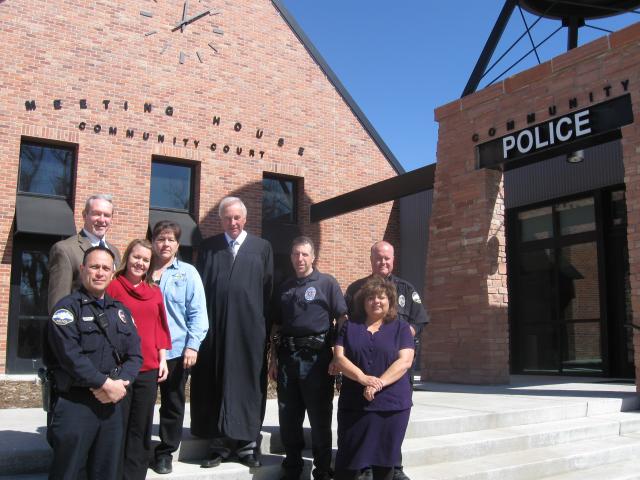Mark Halsey of Flinders University Law School discusses key findings of an evaluation of Australia’s first community court.
ROBERT V. WOLF: Hi, I’m Rob Wolf, director of communications at the Center for Court Innovation and
I’m in Washington D.C. at Community Justice 2012. I’m speaking with Mark Halsey. He’s
a professor of criminal justice at the Flinders Law School in Adelaide, Australia, and he was also one of the joint
leaders of the team that evaluated the Melbourne Neighbourhood Justice Centre. Mark, first off let me just
thank you for taking the time to speak with me
MARK HALSEY: Pleasure. Thanks
for it.
WOLF: What I wanted to do is ask you a little bit about the evaluation. So I
thought maybe you could just start off by describing what the three most important findings were, and maybe you want
to give just a little background about the evaluation, when it was conducted, and how it was conducted.
HALSEY: Okay, so the evaluation virtually started when the center first opened, and it first took
clients in around February 2007. And the evaluation – we collected data for just over two-and-a-half years,
and handed out the final report at the end of 2009, and the court was set up to serve a population of around 80,000
people in a locality called the city of Yara. Quite a mix of people who come under the banner of the lowest
socioeconomic index, indeed in the country, one report found, with some very wealthy pockets in the population as
well, of the catchment area.
In terms of your question around what were the three most
significant findings, the first one is that, I mean in terms of just out and out kind of findings, [we asked] “Was
this thing a success? One of the things that we were charged with measuring was the degree of community
participation. There has to be a big focus on the Community Justice Center, the neighborhood justice center, and
we found kind of high levels of community participation and satisfaction, and it was evidenced by people reporting
that not only had the NJC given them the opportunity to be heard about justice and local community issues in their
area, but they also saw—around 50 percent of everybody surveyed reported that their decisions have been reflected
in things the Community Justice Center or neighborhood justice center had done.
Another
big finding is that over time, everybody asks the recidivism question. Now the court didn’t just handle
criminal matters. It sat as a children’s court, it sat as a VCAT, or Victorian Civil Administrative Tribunal,
you know, like residential tenancy matters and so forth. It heard a wide range of matters. The majority of the matters
were criminal matters, however. We looked at a sample of NJC clients and they were following up for about, I think
it was about 16 to 18 months, against the control group from other courts with similar backgrounds, kind of offense
histories, times in and out of court and so forth. And what it shows is the survival times of NJC clients
was slightly better than the control group. It may have came down to something like 7 to 10 percent lower recidivism
rate. I think one of the other clear results was the compliance rate on community-based orders and doing community
service that proved to be a better compliance rate than the state average.
WOLF: Let
me ask you about something you brought up in your presentation that I thought we could discuss briefly and that was
what happens in the court room, in terms of who speaks. And you made a point that you found that beyond
the attorneys, the prosecutor and defense, other people including the defendant were much more likely to have an
opportunity to speak and be heard in the courtroom than in a conventional setting. And I wonder if you
could just say a little more about that.
HALSEY: Sure. We did look at, we
ran a series of court observations at the neighborhood justice center court and two comparative sites as well, two
kind of regular, traditional magistrate courts, and we were very interested in, to what extent do people in the court,
engaged in the process of the matter or the case, speak. What was interesting was that defendants themselves
were not only far more likely to be called on to speak, to be asked to speak by the magistrate, but they themselves
would ask to speak, in a non-prompted way to the magistrate far more often than in other courts, which to us I guess
indicated a degree of trust or, you know, a sense that what they wanted to say would be taken seriously, and they
felt they could actually put their own views on the agenda, if you like.
One of the
other important things about the NJC court, as opposed to other courts, is the presence of other support people there.
So if you’re dealing with a clinician or a counselor or whatever, for mental health, alcohol and drugs, financial
counselor, if they needed to be in court to either support or clarify things immediately for the magistrate, they
were far more likely to be there and understand something about that person’s situation – their history, where
they need to go, and where they’re at in their kind of recovery process – if I can put it like that – and to
inform the magistrate of that. Which made for a much more holistic hearing, if you like.
WOLF:
There was one other thing you mentioned, that it was absolutely fundamental—I think those are the words you used—to
think about the way the magistrate is chosen, or in our case usually the judge in the United States. I thought maybe
you could just explain a little bit more about that, but it also raises for me the question, does it become personality-driven,
and if the personality of the judge is so crucial, does that make it harder to, say, replicate in different settings?
HALSEY: Look, it does make it slightly more challenging because people are unique, but I think,
you know, they did exceptionally well in appointing the magistrate that they did, and I think one of the best things
that they can do is to try to really try to map – what are the great strengths of that particular magistrate?
Why does he work in that scenario and so when they go to fill that position again, that at least some of those features
can be present. And I think, you know, it’s been said here at the conference as well that, you know, you need
someone that is willing to move away, if you like, from kind of the moral condemnation script that kind of inhabits
a lot of court kind of operations, and that is willing to canvas some other kind of way of operating, like the therapeutic
justice, like procedural justice, to actually kind of, in a sense, be willing to work with individuals and work to
understand the things that underpin their offending, if indeed they’re before you as a criminal defendant. No
one’s irreplaceable. It’s just a matter of going about the business of selecting someone very carefully
and not thinking you can just slot someone in and they’ll be overwhelmed by the climate and they’ll just
automatically changed. There has to be some kind of integration process.
WOLF:
So let me ask you one more question, Mark. What would you say are the three most critical factors to a community
court’s success?
HALSEY: Okay, so the things that we know, I think ultimately in
the final report, were a single magistrate. So the magistrate gets to know, basically, everybody that comes before
them and they can set up some kind of tangible relationship with them, and the monthly—or however often the court
reviews for specific people—is really important. The second things is that it is really important to have
a neighborhood justice officer, or a person that can act as the go between or liase between the magistrate and the
people who are trying to help clients in a more direct sense, you know, the clinical team and the other members of
the larger support team, like financial counseling, homelessness, whatever. There needs to be that person
so that you can maintain the independence of the magistrate in court, and that they’re not seen to be interfering
in those other clinician’s roles
WOLF: Would that parallel the role of the resource
coordinator that we have in community courts?
HALSEY: I don’t know the answer.
It may well, but if it is someone that basically is in court the majority of time, and knows what the magistrate
is doing, and knows what other aspects of the center are doing for particular clients who are in the court, then
that would be right.
WOLF: Yeah, that sounds pretty parallel.
HALSEY:
So that’s the second thing. The other thing is that it has to be, or from our point of view, there is huge weight
to be attached to the on-site nature of services so that clients don’t get shunted or lost between and order
from a court and trying to either find a service some distance away, or hope that they turn up to that, or hope that
they go to their community corrections office somewhere else.
WOLF: Well great, thanks
so much, Mark,
HALSEY: It’s a pleasure, Rob. I’m really happy to
be here.
WOLF: I’ve been speaking with Mark Halsey, who is a professor of Criminal
Justice at the Flinders Law School in Adelaide, Australia. We’ve been talking about what he learned
as one of the joint leaders of the team who evaluated the Melbourne Justice Center.
HALSEY:
Thanks Rob. Can I just also acknowledge the other members of the team and that’s Professor
David Bamford from Flinders University, Dr. Stuart Ross from University of Melbourne, and we also had assistance
from PriceWaterhouseCoopers, who did a cost-benefit analysis for us. And the Social Research Center of North Melbourne,
and the Brotherhood of St. Lawrence based in Collinwood in Melbourne.
ROB WOLF: I am
Rob Wolf, Director of Communications at the Center for Court Innovation. If you want to hear more of our
podcasts you can visit our website at www.courtinnovation.org.
(March 2012)

Mark Halsey, left, answers a question as part of a panel on community
court research at Community Justice
2012.
Podcast: Play in new window | Download
